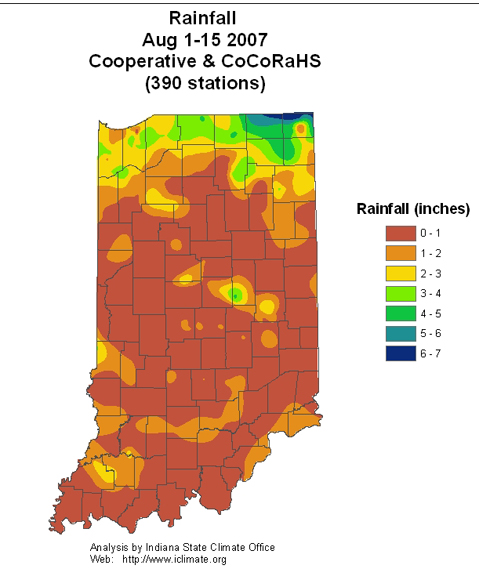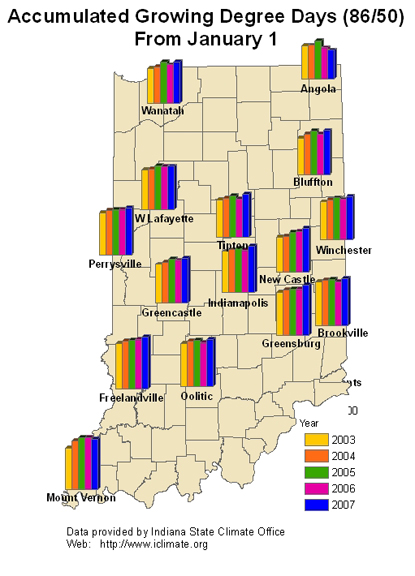Pest & Crop Newsletter, Entomology Extension, Purdue University
![]()
2007, Year of the Suckers! – (Christian Krupke, John Obermeyer, and Larry Bledsoe)
Sucking arthropods, some of them not the usual suspects, have been attacking our crops all season. It started with soybean aphids and mealybugs in May when the crop had ample moisture. During the recent conditions of drought and heat, we are seeing aphids both in soybean and corn. Not to mention the flurry of spider mites and whiteflies that have aroused curiosity. As typical every year about this time, a good rain will cure many woes.
Soybean Aphid Update: If there ever been a year that illustrated the importance of the need to scout each and every field before treating, this is it. Soybean aphid numbers this year have varied greatly from field to field, some fields that have been well over threshold a week ago right beside fields with insignificant numbers. A complicating factor is that winged aphids are on the move, and fields can almost “clear out” overnight in some areas. Soybean aphid are cued by various stimuli, including day-length, population density, and predator pressure to form wings and fly to new, unexploited food sources. With this is in mind, pay close attention to very late-planted soybean fields, such as double crop. The bottom line…keep scouting!

Close-up of soybean aphid ready to develop wings
Aphids in Corn: We have investigated a few fields in northwestern counties following reports of aphids colonizing corn plants. Initially we thought the culprit was the very common corn leaf aphid. However, while in the fields it was evident that two other species of aphid are present, one was the bird cherry-oat aphid, the other as yet unidentified. A very small percentage (<5%) of the plants were heavily colonized. Most aphids were on the middle to bottom of the canopy and that most fields were in the dough stage of growth. Before and during pollination is the most critical time where aphids in corn may cause economic problems, especially when their excrement (“honey dew”) potentially interferes with pollination. We typically do not see aphid problems later in the year, but are receiving more and more reports of high aphid activity. We will follow this and update in later issues of Pest&Crop.

One of few heavily aphid colonized plants

Bird cherry-oat aphid look similar to corn leaf aphid
![]()
First Western Bean Cutworm Damage Found - (Christian Krupke, John Obermeyer, and Larry Bledsoe)
Finally, after two years of capturing moths, we have found some damaging larvae and can officially call the western bean cutworm a pest in Indiana. We have received a specimen and pictures that confirm both larvae and their damage from a northern Jasper County cornfield. The overall damage in the field was minimal, but some ears were heavily damaged. We suspect that over the years, this damage will become more widespread and in certain years perhaps lead to yield losses, if the experiences of other states dealing with this pest are any indication. How long that takes is anybody’s guess, but the WBC is likely here to stay for a while.
Should you find ear damage and worms matching the following picture, please let us know (765-494-4912). Thanks!
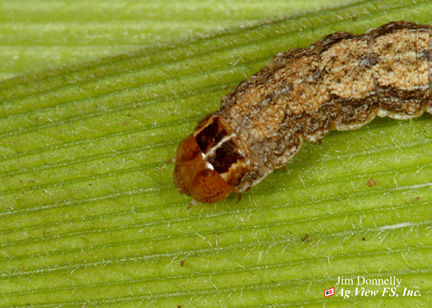
Western bean cutworm larva head, note two distinct black rectangles
behind the head (Photo credit: J. Donnelly)
Western bean cutworm ear damage, note multiple worms
![]()
Click here to view the
Black Light Trap Catch Report - (John Obermeyer)
Soybean Sudden Death Syndrome – (Andreas Westphal, Scott Abney, and Gregory Shaner)
- SDS can occur even in a dry season.
The growing season of 2007 has been uncharacteristically dry. Soil conditions were favorable for field operations in late April and early May. Planting operations progressed mostly in proper seedbeds. So far, based on previous years’ experience, conditions have been unfavorable for SDS this year. Severe SDS is often associated with excess soil moisture as plants move into reproductive stages. However, in fields with a history of SDS the disease may develop in the absence of wet soil during this period of plant development. Even in this dry year, soybean fields should be monitored for presence of SDS.
Sudden death syndrome is caused by the soil-borne fungus Fusarium virguliforme (previously—Fusarium solani f. sp. glycines). The fungus occurs in soybean fields in nearly all areas of Indiana, and can cause SDS when conditions are favorable. Fusarium virguliforme invades soybean roots early in the season, but it is only at mid-season when plants are in reproductive growth stages that aboveground symptoms of SDS occur. Heavy rains during reproductive stages are a predisposing factor for SDS, but symptoms have appeared this year in some fields that have not received heavy rains. During reproductive stages of soybean the fungus can produce toxins in the root system, which the plant translocates to the leaves, where they induce foliar symptoms. Symptoms of SDS have appeared this year later than normal, and so far primarily in highly susceptible soybean varieties growing in fields with a history of SDS.
In affected plants, leaf tissue between the major veins turns yellow, then brown. Soon, the leaflets die and shrivel. In severe cases they drop off, leaving the petioles (leaf stalks) attached. Stem symptoms offer the best clues for diagnosis of SDS and for distinguishing this disease from brown stem rot. When split, the lower stem and taproot of a plant with SDS will exhibit a dark cortex, but white to tan pith. Brown stem rot may cause similar foliar symptoms, but the leaflets tend to remain attached to the petioles. Plants with brown stem rot have a dark pith, but the cortex is not much discolored. If a plant with symptoms of SDS is dug up when soil is moist, there may be small, light-blue patches on the surface of the taproot. These are spore masses of the SDS fungus. As the plant dries, this color will fade, but when it is seen, in conjunction with the other symptoms mentioned above, a diagnosis of SDS is strongly indicated.
Early planting into cool soils favors SDS. It is not possible to predict how severe or widespread SDS will be this year, but growers should be on the alert for appearance of symptoms over the next 2 or 3 weeks. Plants killed early by SDS may produce no seed. Plants that develop symptoms later may produce almost as many pods and seed as healthy plants, but seed may be smaller.
There is no remedy for plants that develop SDS. Fungicides will have no effect on this disease. Growers should keep records of which fields develop SDS. Even better, growers should map problem areas within fields. SDS rarely affects entire fields. More often, the disease shows up in patches—low areas or areas of compacted soil are often the first to show symptoms. After the first appearance of symptoms, patches may enlarge and more patches may develop as the season progresses. Identification of problem fields can be useful for future planting decisions. A grower should choose a soybean variety that is less susceptible to SDS for planting into fields with a history of SDS. Although there are no highly resistant varieties, some are much less susceptible than others. Late planting may reduce the risk for SDS, but this may not apply when May is unusually cold.
Although Fusarium virguliforme alone can cause SDS, there has long been an observed association between this disease and presence of the soybean cyst nematode in a field. Recent studies at Purdue have shown that symptoms become much more severe when both the fungus and the nematode are present in a field. If a field develops symptoms of SDS and the grower does not know the status of soybean cyst nematode in that field, soil should be tested to determine population levels of this pest.

Leaf with typical interveinal necrosis
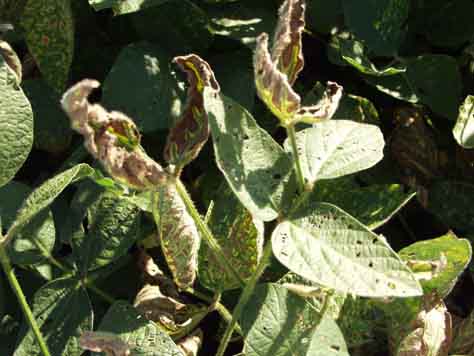
Canopy view of diseased and healthy leaves
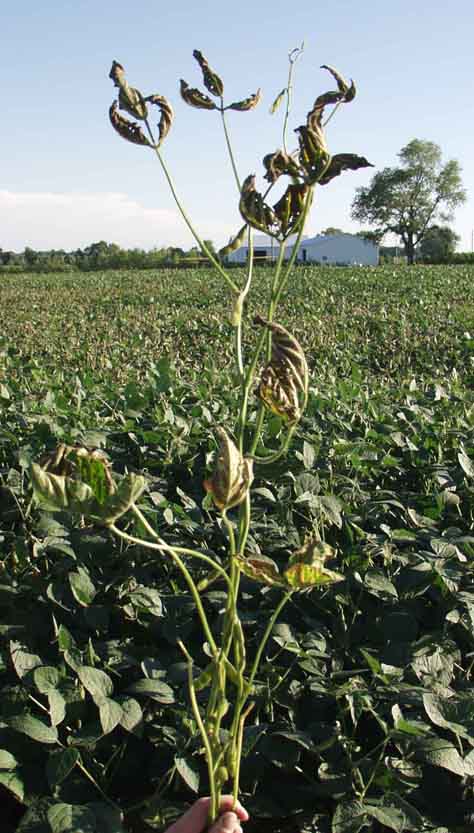
Entire plant with some of the leaves dropped and only the petioles remaining
![]()
